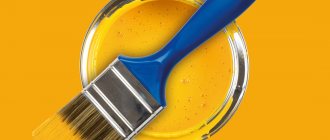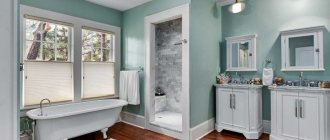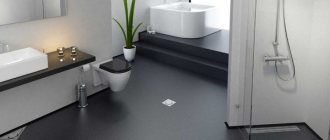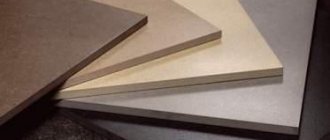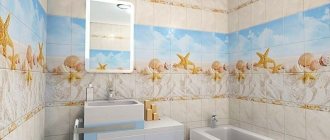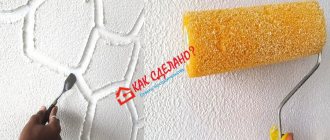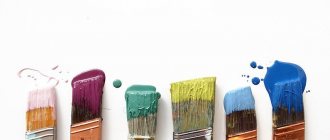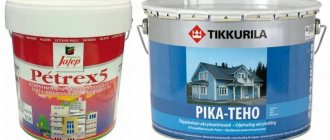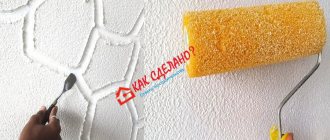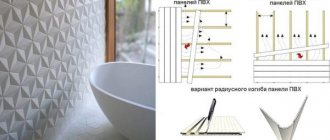The bathroom is a room with a rather specific climate, as there is constantly high humidity and significant temperature changes. Therefore, when choosing building materials for the renovation of a given room, you should pay special attention to the resistance of the materials to adverse conditions, this also applies to paints.
Of all types of building materials, paint is the most affordable option, especially if all repair work is done with your own hands.
Paint selection
Before you start choosing a suitable paint option for painting a bathroom, you must first find out what types of paints are intended for these purposes, their properties and features.
There are several types of moisture-resistant paint for painting a bathroom on the modern market: water-based, latex, acrylic, silicone.
It is very important to remember that oil paint is absolutely not suitable for painting walls and ceilings in the bathroom. After drying, it creates a special thin, sealed layer in the form of a film on the surface.
It is permissible to use such paints only for painting floors in bathrooms. Enamel is perfect for painting metal elements.
The best option for painting various surfaces in the bathroom is a paint and varnish mixture; it retains its original properties for a long time, is moisture-proof, can withstand temperature changes and prevents the growth of mold and mildew. In addition, you can also use water-based and water-dispersion paints.
Water-dispersion coatings
In most cases, water-dispersion coatings are used for wet rooms. In most cases, they are based on polymers:
- vinyl,
- acrylic,
- latex,
- polyurethane, etc.
They are suspended in water as a dispersion. Thanks to this, such materials have no odor.
Due to the fact that water-dispersion emulsions do not contain solvents, they are pure. It is convenient to work with them, since there is no need to use a respirator and then remove the smell from the room. Dispersion coatings have excellent adhesion to all types of substrates.
Mineral paint
Mineral coatings are waterproof, but not durable enough.
The basis of mineral (water-based) coatings is slaked lime or Portland cement. These paints are moisture resistant. However, their service life is short. Because of this, they are now rarely used.
The only advantage of mineral paint is its low cost. It makes it possible to make cheap repairs to a wet room. But here it is worth considering that the finishing will have to be updated after 2-3 years.
Acrylic compounds
Acrylic-based coatings are most in demand for finishing wet rooms.
Advantages of acrylic paints:
- ease of use - the composition adheres well and dries quickly;
- high level of elasticity - the coating does not peel off or crack;
- long service life;
- moisture resistance;
- resistance to aggressive chemicals;
- resistance to temperature changes.
Thanks to all these qualities, acrylic paint is the optimal choice for walls in wet rooms. The water-repellent qualities of this coating allow it to be used even for repairing bathtubs.
Latex coatings
Latex paint has the highest degree of moisture resistance.
The basis of latex paints is artificial rubber. After applying the composition to the walls, ceiling or floor, the water dries, and the filler particles create an elastic film. It adheres securely to the base.
Latex coatings are recommended for wet areas because they create a water-repellent and durable finish. They dry quickly and do not emit harmful substances.
Wet areas are best coated with semi-gloss or matte paint.
Latex-based paints are available in different gloss levels. As a result, it is necessary to select in advance from the following coverage options:
- super matte;
- matte;
- semi-matte;
- super glossy;
- glossy;
- semi-gloss.
In damp rooms, surfaces should not be painted with a composition with the highest gloss level. The mirror effect can quickly become boring and irritate you.
Matte finish is optimal for spacious rooms. In small rooms it is better to use glossy or semi-gloss paints.
Walls with a shiny surface must be carefully prepared. The gloss emphasizes even small unevenness of the base. The matte finish disguises them.
Silicone and silicate paint
Silicone coatings are ideal for wet rooms.
A good choice for a wet room would be silicone or silicate paint. They have good water-repellent qualities. At the same time, the finish allows air to pass through.
The main disadvantage of silicate and silicone coatings is their high cost. These paints are more expensive than their acrylic counterparts. But this drawback is offset by the durability of the finish.
Water-based paint for the bathroom
When choosing paint for the bathroom, you should not ignore water-based compositions. This type of paint has many advantages:
- Affordable cost of such solutions.
- Water-based compositions do not contain substances harmful to human health.
- Dries quite quickly.
- This type of paint does not lose its original data when exposed to ultraviolet rays.
- There is no smell at all.
- You can change the color using special color tints.
- Suitable for painting surfaces in any room.
Read here! Types of the best paints for metal - compositions, differences and methods of application for interior and exterior work
It is very important to consider that water-based compositions are easily washed off from the surface with water. Therefore, to remove small dirt you should use a dry, clean cloth.
These types of paint are not recommended for painting surfaces in contact with water. When painting such areas, you should use solutions that have increased resistance to various mechanical influences.
Is it advisable to paint everything?
Of course not. For example, glass is not painted with all compounds. It is more profitable and more aesthetically pleasing to provide inserts made of frosted, colored and other types of opaque glass (including acrylic). These glasses look very modern. Moreover, glass inserts can be combined, modified, and replaced.
Painting concrete is also rarely done, since concrete can be easily plastered with decorative compounds. As the original surface, concrete remains mainly in basements and cellars. In addition, due to the porosity of concrete, paint consumption increases.
There is practically no point in painting plastic and tiles. Painted plastic looks much worse, since only painting with thick paints can avoid streaks. When painting plastic, you have to increase the layer of coloring composition, and its durability on plastic will in many cases be minimal due to low adhesion. If the need for painting is great, then the plastic should be treated with emery cloth before painting.
Plywood (as an element of arrangement of covered balconies and loggias) can also be painted. Plywood is processed in the same way as wood. Since plywood often serves as a substrate for floors made of wood, laminate, etc., it is enough to paint it in one layer.
It is better not to paint wood (in particular, parquet) at all, but to varnish it. Well-dried wood is not prone to rotting, so it is easier to extend the service life of wood coatings using less drastic methods. In addition, old paint from wood is quite difficult to remove.
Acrylic paint
Acrylic compounds are the best option for treating bathrooms; they have excellent technical and performance characteristics.
The modern specialized building materials market presents a large assortment of acrylic paints, various colors and shades. After treatment with such compositions, surfaces are significantly less subject to contamination and acquire a moisture-repellent effect.
In addition, caring for surfaces treated with acrylic compounds is quite simple; you just need to wipe with a damp cloth if any dirt appears.
Among other things, it should be noted that acrylic paints contain special additives that increase resistance to fungus and mold.
Painting features
The quality and durability of a painted surface depends not only on the choice of coating, but also on the quality of its application. Therefore, below we will consider how to properly paint wood with waterproof paintwork.
So, the instructions look like this:
- You need to start work by preparing the surface - the wood must be cleaned of the old coating, putty and sanded if necessary.
- Then the paint is prepared - shaken thoroughly; if the composition is tinted, then the required amount of color is added to it to obtain one or another shade.
- Next, apply the composition with your own hands onto the wooden surface in a thin, even layer. To do this, you can use a sprayer, paint roller or brush.
- After the first layer has hardened, the coating is applied again. In most cases, two coats are sufficient to achieve an even color and a smooth surface.
Advice! Before painting, the wood can be coated with an antiseptic primer, which will improve the adhesion of the paintwork and also protect the wood from the effects of microorganisms, mold, etc.
This completes the painting process.
Silicone paint
Modern silicone paints are a completely new type of finishing building materials; they have excellent characteristics and properties, such as increased resistance to mechanical stress, temperature changes, and humidity.
The disadvantages of silicone paints include their high cost.
DIY painting instructions
Let's assume that we have already chosen the paint. All that remains is to prepare a simple tool:
- roller (fur or foam);
- several brushes of different widths with securely fastened bristles;
- masking tape - to protect surfaces not intended for painting;
- a cuvette that saves paint and allows you to remove excess material;
- spatula - for occasional cleaning.
A spatula will not be needed if the walls are initially ready to be painted. This means that they must be plastered, perfectly smooth, without traces of old paint or glue, without cracks or depressions
It is better to remove shelves, mirrors, hangers, hooks and other devices from the walls that interfere with the uniform application of paint.
Some experts insist on observing the temperature regime. Optimal indicators are from +10ºС to +20ºС. It is also important to adjust the humidity, which should be within 50-70%.
To increase this indicator in winter, use humidifiers, and if they are not available, use buckets of hot water.
Procedure:
- Prime the clean surface with a special solution. There are many types of universal-type interior primers, but it is better to choose one labeled “for paint.”
- After the primer has completely dried, we begin to apply paint with a brush in the corners, starting from the light source (window or wall lamp). We also use a brush to paint skirting boards, narrow parts, and interior elements (for example, panels).
- We paint wide surfaces last, using a roller. To ensure quality work, follow the movements - from top to bottom, then from left to right, then from top to bottom again. The technique is quite simple.
Don’t forget about the subtleties of painting: remove excess paint on a ditch or a special mesh so that there are no streaks or smudges.
To achieve a rich color, you will need to apply 2-3 layers of paint, each subsequent repetition should be done after the previous layer has completely dried
Drying time is indicated in the instructions: from 3 to 6 hours. Usually the first layer dries 2-3 hours before the rest.
Some tips from professionals - representatives of Tikkurila:
Glossy bathroom paints
An important criterion when choosing paint for the bathroom and not only is the interior of the room. For small rooms, you should opt for glossy coatings, as this will help visually expand the space due to a special, mirror effect.
In addition, glossy coatings are much easier to clean and have excellent elasticity. However, it is necessary to take into account the fact that a glossy coating implies an absolutely flat base, since gloss will only emphasize and show everything, even the slightest defects on the surfaces.
Wall decoration
Painting walls in the modern sense has become something between painting work and the work of a sculptor/painter.
Textured surfaces are obtained by using acrylic-based textured paints with fillers:
- atacama
– metal pigments, quartz sand; - Mizuri
– modified starch; - relief
– quartz chips; - Marseilles wax
- imitates stone, bark.
Textured paint, on the contrary, is homogeneous and the decorativeness of the surface is achieved using:
- brush/spatula;
- relief roller;
- stencil;
- sponges.
Thanks to the acrylic in the coating, it retains its protective and hygienic properties, and visually differs little from expensive plaster.
Matte
For painting bathrooms where there are minor defects on the surfaces, matte compositions are an excellent option.
Quick-drying, odorless paint for interior work - main types, selection tips and benefits of useThe best aerosol paint in cans - main types, application features and advantages of use
The best water-based paint - ranking of the best manufacturers of 2018
However, before choosing this type of paint, you need to think carefully about everything, since even the slightest dirt is noticeable on such coatings; it will not be possible to remove them with a damp cloth, therefore, there is a need to repaint the surface.
Therefore, in order to decide which paint for the bathroom is better, it is necessary to study all the technical and operational characteristics, properties, and scope of application. Of course, you should buy paint only in specialized retail outlets to avoid counterfeit and low-quality products.
Alkyd enamel
Alkyd coating is reliable, but not environmentally friendly enough.
Finishing in wet areas must be moisture resistant. This basic requirement is fully met by enamels based on alkyd resins and organic solvents. The coating creates a dense film that repels water.
Thanks to this, the lined surfaces not only become moisture resistant, but they can also be washed using cleaning agents. This helps you clean the room without any problems.
All alkyd enamels marked as PF-115 are suitable for wet rooms.
The disadvantages of alkyd paints are their smell and long drying time. The coating must be applied using a respirator. The room must be ventilated for a long time until it dries.
Photo of the best waterproof paint for the bathroom
How to choose façade paint for exterior use - a review of popular manufacturers and a rating of the best paints for exterior useWhich oil paint is better - a review of the best brands and criteria for selecting paints
The best interior paint for walls - 2022 rating and instructions for using interior paint
Reviews
User reviews can help you determine which odorless bathroom paint to choose. For example, the paint “Dulux Dazzling White” for the kitchen and bathroom is characterized by users as follows:
- Olga. The paint quality is good. Dries quickly, there is almost no smell. The ceiling in the kitchen needed to be painted. I chose this brand intuitively because I heard flattering reviews about it. To paint the walls, I added color. The paint color is really white, even snow white. If you paint a large area at once, the smell is noticeable, but quickly dissipates. I used a roller for the job - painting the ceiling was convenient and quick. The only drawback of the paint is that it is too expensive.
- Alexandra. I was choosing paint for the interior decoration of a country house. I bought the paint on the advice of friends. The store was confused by the high price. But the seller praised the paint from all sides, so I chose it. Now I know for sure - I didn’t make a mistake. The color is somewhat silky, and the ceiling is easy to clean.
- Eugene. We were renovating the kitchen, so I decided to choose white paint color. I thought about taking such a composition so as not to update it for several years. I chose Dulux Dazzling White. I was surprised how thick the paint is. Lays down smoothly and has almost no odor. And it dries very quickly. The only thing that was a little disappointing was that the price was a bit high.
As you can see, reviews about this product are more often positive. This is explained by the high demands placed on modern paints and varnishes.
Recommended Posts
How to paint walls with water-based paint without streaks
Quick-drying floor paint
Mixing colors
Decoding paint markings
Wood varnish for exterior use
Paint for painting on walls
How not to buy a fake?
If you want to buy high-quality bathroom paints, then you should listen to the following tips:
- Before purchasing, carefully study the label; it should indicate the composition, as well as the manufacturer’s details with addresses and telephone numbers. It’s not worth buying paint produced by someone unknown;
- Please note that acrylic paint is a rather expensive material, so if a seller offers a suspiciously cheap product, you should be wary;
- You should not buy paint on street trays; it is better to make a purchase in a trusted store.
Bitumen based solution
The main component is a petroleum product. Bitumen is a solid mixture of carbon, sulfur, oxygen, and nitrogen metal-containing components. The material must be melted, for example, using a hair dryer. Pour the resulting liquid bitumen into a clean container. In another clean container, mix silicone sealant with gasoline. Stir the mixture until smooth so that there are no lumps.
Combine the components in one container. The working solution is prepared at the rate: 310-350 milligrams of silicone composition are required for 1 liter of liquid resin. The bitumen mixture becomes elastic and repels moisture well . Apply with a brush or spray.
